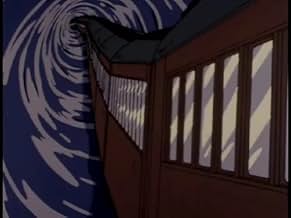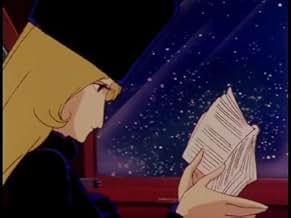La aventura de un niño a bordo de un tren espacial que viaja a un sinfín de mundos increíbles.La aventura de un niño a bordo de un tren espacial que viaja a un sinfín de mundos increíbles.La aventura de un niño a bordo de un tren espacial que viaja a un sinfín de mundos increíbles.
Explorar episodios
Argumento
¿Sabías que…?
- TriviaLeiji Matsumoto was inspired by Kenji Miyazawa's novel "Night on the Galactic Railroad," about a steam train flying through space.
- ErroresThe number of cars on 999 sometimes varies. While this can be explained in different episodes by the idea that cars may be added in between episodes, the number of cars also vary within each episode, which isn't explainable.
- ConexionesFeatured in Making Gundam: The Inside Story (2019)
- Bandas sonorasGinga Tetsudô 999
Lyrics by Jun Hashimoto
Composed by Masaaki Hirao
Arranged by Nozomi Aoki
Performed by Isao Sasaki
Opinión destacada
"Galaxy Express 999" is a celebrated Japanese animated TV series that ran from 1978-81 for 114 episodes. It tells the continuing tale of a flesh-and-blood boy, Tetsuro, in a far future society, who boards the Galaxy Express 999, a passenger train that flies through space from one end of the galaxy to the other, with the dream of reaching a legendary planet that offers free machine bodies to humans. (On Earth only the poor have flesh-and-blood bodies; people with money have already traded their organs for machine parts.) Tetsuro's traveling companion is the mysterious Maetel, a tall, beautiful blond woman in fashionable dark winter clothing who provides Tetsuro with the pass he needs to travel. The train stops at various planets and moons along the way and Tetsuro and Maetel get involved in other people's storieseither humans also wanting machine bodies (and sometimes resorting to nefarious means to get Tetsuro's pass) or machine people who desperately miss their human bodies. Gradually Tetsuro gets the message that machine bodies don't necessarily result in power or happiness. A frequent theme of the series is separation, as in disrupted families, children removed from parents, and lonely, displaced people craving the warmth and humanity of Tetsuro.
What truly distinguishes this remarkable series is its mesmerizing fairy tale quality. I hesitate to even call it science fiction because there's such an air of fabled unreality to it all, and the artwork reflects this in its storybook style of illustration. Everything has the painted look of the best children's book artists. The stark, dramatic quality of the background planetary landscapes and the washes of color to create a mood help to establish an atmosphere befitting the particular setting and situation. The series is a work of art.
The character design for Tetsuro may seem a little too cartoonish for some, with its round face, dots for eyes and big gaping mouth, but the animators and the Japanese voice actor use all the tools of their trade to bring Tetsuro to endearing, energetic life. The women all tend to be cut from the same mold: tall, willowy, slender and long-haired, with plaintive voices and sad eyes. Leiji Matsumoto, writer-artist of the manga series on which the TV program was based, has attributed the influence on his style of drawing women to a teenaged viewing of the 1955 French film, MARIANNE DE MA JEUNESSE (Marianne of My Youth) and the actress who played the title role, Marianne Hold.
Leiji Matsumoto was one of the most distinctive manga artists to make his mark in anime. Another series he created, "Captain Harlock," debuted the same year as "Galaxy Express 999." GE999 spawned two feature-length movies (in both of which Captain Harlock appears) and several TV specials, including "Eternal Traveler Emeraldas," "Can You Love Like a Mother?" and "Can You Live Like a Warrior?", all also reviewed on this site. As of this writing, however, only the two GALAXY EXPRESS movies have been distributed in the U.S. The original series and its TV special spin-offs remain unavailable even though the series once played, in subtitled format, on educational TV stations here. Part of the manga series has been published in English and is currently in print. We can only ask what the rights-holders of the TV series are waiting for.
What truly distinguishes this remarkable series is its mesmerizing fairy tale quality. I hesitate to even call it science fiction because there's such an air of fabled unreality to it all, and the artwork reflects this in its storybook style of illustration. Everything has the painted look of the best children's book artists. The stark, dramatic quality of the background planetary landscapes and the washes of color to create a mood help to establish an atmosphere befitting the particular setting and situation. The series is a work of art.
The character design for Tetsuro may seem a little too cartoonish for some, with its round face, dots for eyes and big gaping mouth, but the animators and the Japanese voice actor use all the tools of their trade to bring Tetsuro to endearing, energetic life. The women all tend to be cut from the same mold: tall, willowy, slender and long-haired, with plaintive voices and sad eyes. Leiji Matsumoto, writer-artist of the manga series on which the TV program was based, has attributed the influence on his style of drawing women to a teenaged viewing of the 1955 French film, MARIANNE DE MA JEUNESSE (Marianne of My Youth) and the actress who played the title role, Marianne Hold.
Leiji Matsumoto was one of the most distinctive manga artists to make his mark in anime. Another series he created, "Captain Harlock," debuted the same year as "Galaxy Express 999." GE999 spawned two feature-length movies (in both of which Captain Harlock appears) and several TV specials, including "Eternal Traveler Emeraldas," "Can You Love Like a Mother?" and "Can You Live Like a Warrior?", all also reviewed on this site. As of this writing, however, only the two GALAXY EXPRESS movies have been distributed in the U.S. The original series and its TV special spin-offs remain unavailable even though the series once played, in subtitled format, on educational TV stations here. Part of the manga series has been published in English and is currently in print. We can only ask what the rights-holders of the TV series are waiting for.
- BrianDanaCamp
- 29 ene 2005
- Enlace permanente
Selecciones populares
Inicia sesión para calificar y agrega a la lista de videos para obtener recomendaciones personalizadas
Detalles
Contribuir a esta página
Sugiere una edición o agrega el contenido que falta

Principales brechas de datos
By what name was Ginga Tetsudo 999 (1978) officially released in Canada in English?
Responda


























